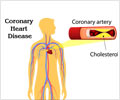Greater exposure to perfluoroalkyl (common household) substances was associated with lower rates of existing coronary heart disease in adults with diabetes.

‘Chemicals found in nonstick cookware, cleaning products and paint may help lead to new treatments for heart disease in diabetic adults.’





In this study, researchers investigated the association of blood PFAS levels to coronary heart disease using data gathered as part of the C8 Health Project. A large, community-based study launched in 2005, the C8 Health Project was created to address the potential health effects stemming from contamination of West Virginia and Ohio drinking water with the PFAS perfluorooctanoic acid (also called C8) between 1950 and 2004. Of the 5,270 adults with diabetes in this study--led by Baqiyyah Conway, University of Texas Health Science Center at Tyler--1,489 had been diagnosed with coronary heart disease previously, and 3,781 had not. The researchers investigated the relation between blood levels of four PFAS and coronary heart disease, considering the participants' age, sex, race, BMI, smoking history, duration of diabetes, kidney function, chronic kidney disease and other traits.
"In this cross-sectional study of adults with diabetes, the likelihood of reporting a diagnosis of coronary heart disease declined with increasing blood levels of four PFAS after adjustment for demographics, BMI and other factors," Innes said.
The four PFAS were also inversely related to the likelihood of coronary heart disease in adults without diabetes, but these associations were far less pronounced than in people with the condition.
It remains unknown exactly how PFAS might lower heart disease risk, but as Innes pointed out, "several factors could explain the inverse association." For example, PFAS may reduce inflammation. It's also possible that PFAS increases the body's sensitivity to insulin or ability to transport oxygen. All of these effects might promote heart health.
Advertisement
"The next step will be to conduct additional longitudinal studies in the C8 and other cohorts in order to assess the relation of baseline PFAS blood levels to subsequent risk for incident coronary heart disease in those with and without diabetes," Innes said. "Such research will help determine if the inverse association observed in this study might reflect a causal association between PFAS and the development of coronary heart disease."
Advertisement
"The findings of this paper in no way suggest that PFAS should be released into drinking water or the environment," Innes said. "With few exceptions, you wouldn't want any substance--including those with certain established health benefits, such as coffee and aspirin--contaminating the water. It is important to remember that PFAS are complex compounds that may have both positive and negative effects on health."
Source-Eurekalert















